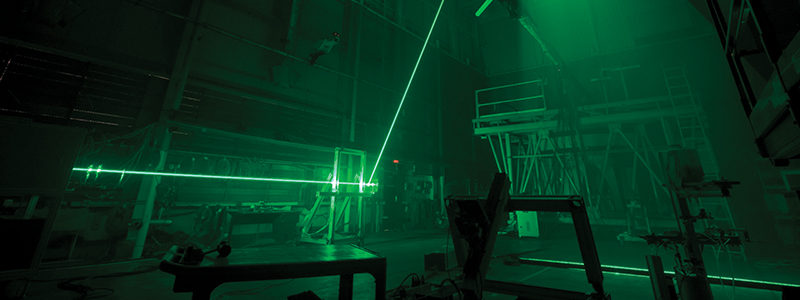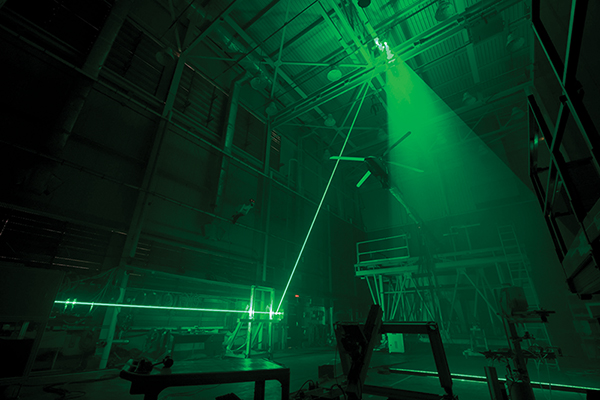
Pressure-Sensitive Paints Advance Rotorcraft Design Testing
NASA Technology
The rotors of certain helicopters can spin at speeds as high as 500 revolutions per minute. As the blades slice through the air, they flex, moving into the wind and back out, experiencing pressure changes on the order of thousands of times a second and even higher.
All of this makes acquiring a true understanding of rotorcraft aerodynamics a difficult task. A traditional means of acquiring aerodynamic data is to conduct wind tunnel tests using a vehicle model outfitted with pressure taps and other sensors. These sensors add significant costs to wind tunnel testing while only providing measurements at discrete locations on the model’s surface. In addition, standard sensor solutions do not work for pulling data from a rotor in motion.
“Typical static pressure instrumentation can’t handle that,” explains Neal Watkins, electronics engineer in Langley Research Center’s Advanced Sensing and Optical Measurement Branch. “There are dynamic pressure taps, but your costs go up by a factor of five to ten if you use those. In addition, recovery of the pressure tap readings is accomplished through slip rings, which allow only a limited amount of sensors and can require significant maintenance throughout a typical rotor test.”
One alternative to sensor-based wind tunnel testing is pressure sensitive paint (PSP). A coating of a specialized paint containing luminescent material is applied to the model. When exposed to an LED or laser light source, the material glows. The glowing material tends to be reactive to oxygen, explains Watkins, which causes the glow to diminish. The more oxygen that is present (or the more air present, since oxygen exists in a fixed proportion in air), the less the painted surface glows. Imaged with a camera, the areas experiencing greater air pressure show up darker than areas of less pressure.
“The paint allows for a global pressure map as opposed to specific points,” says Watkins. With PSP, each pixel recorded by the camera becomes an optical pressure tap. “Instead of having 100 or 200 pressure taps, you can have in theory several million—up to whatever the resolution of your camera is.” Watkins explains that typical wind tunnel testing requires two models: one with very little instrumentation, and a pressure model with a significant amount of sensors applied. “If you can make all of your measurements on one model with PSP, you’ve decreased your model costs by at least a factor of two and preferably your testing costs by about that much,” he says.
PSP technology has been around for almost 20 years, but a PSP solution for gathering instantaneous dynamic pressure data from surfaces moving at high speeds—such as rotor blades—was not available until a NASA partnership led to a game-changing innovation.
Technology Transfer
Innovative Scientific Solutions Inc. (ISSI) of Dayton, Ohio, is the world’s primary commercial supplier of PSP technology. Their PSP products have been in use at Langley, Ames Research Center, and Glenn Research Center.
“We have worked closely with NASA and the Air Force Arnold Engineering Development Center over the years to develop PSP technology into a production tool that can be used in wind tunnels,” says Jim Crafton, Senior Research Engineer for ISSI. Through the Small Business Innovation Research (SBIR) program, the company collaborated with Langley to develop a new kind of PSP data acquisition system that uses Fast PSP. Taking advantage of advances in laser and camera technology, ISSI’s Fast PSP can collect at least 1,000 measurements in the same time that conventional PSP can collect 1, allowing it to capture pressure data from the highly dynamic surfaces, such as those of rotor blades and propellers.
“The opportunity to take our ideas and work with NASA to refine them has allowed us to move the technology ahead quickly,” Crafton says. “Commercially, it is going to be a real success.”
Benefits
ISSI has already translated its SBIR-developed Fast PSP into about $200,000 in commercial sales.
“If you have a fixed-wing aircraft under fairly steady cruise conditions, then slower PSPs are just fine,” says Grant McMillan, ISSI’s head of business development. “But as soon as you have something slender and dynamic like a helicopter rotor that is twisting and turning and flapping, those pressure patterns are changing potentially thousands of times a second. That’s when you need Fast PSP.”
Fast PSP has garnered interest from customers working with helicopter rotors, propellers, wind turbines, and acoustic noise research. For Watkins, the benefits of the innovation are already apparent. Tests at the 14x22 wind tunnel and the Rotor Test Cell at Langley showed the Fast PSP was able to reveal the changes in pressure on a single blade as it rotated around a helicopter.
“We were able to see vortexes shedding off the blade,” Watkins says. “Even with discrete pressure taps, you are not going to see a lot of this unless the taps are placed in the correct locations. It’s answering a lot of questions.” Watkins says the ability to capture this kind of data can influence future rotorcraft to improve performance and allow for radical departures from typical designs.
“It’s a revolutionary evolution of the technology,” says Crafton.
Both ISSI and NASA are working toward applying PSP technology to actual flight tests, which could unveil a whole new range of data for improving aviation.
“We ended up with two things—a measurement capability that enables NASA to do its work, and a commercial product we can sell worldwide,” says McMillan. “It’s a win-win from our perspective.”

ISSI’s Fast PSP, seen here in Langley Research Center wind tunnel tests on a helicopter model, enables the collection of pressure data from rotorcraft—data that is costly to acquire through traditional sensors and not attainable through standard pressure sensitive paint solutions.














